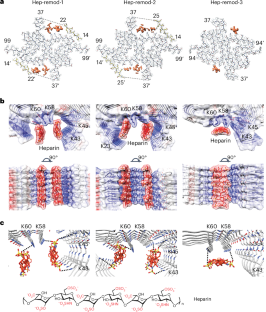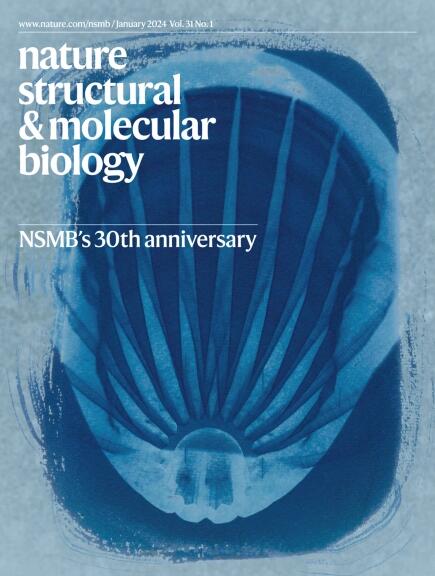肝素和肝素样寡糖对α-突触核蛋白淀粉样纤维的时程重塑和病理干预
IF 12.5
1区 生物学
Q1 BIOCHEMISTRY & MOLECULAR BIOLOGY
引用次数: 0
摘要
淀粉样纤维是一种病理状态的蛋白质聚合物,与各种神经退行性疾病密切相关。多糖在识别淀粉样蛋白纤维和介导其致病性方面发挥着重要作用。然而,淀粉样蛋白与多糖相互作用的机制仍然难以捉摸。我们也不知道它对已形成纤维的结构和病理的影响。在这里,我们使用冷冻电镜分析了成熟的α-突触核蛋白(α-syn)纤维与聚合肝素和肝素样寡糖结合后的原子结构。纤维结构,包括α-syn的螺旋扭曲和构象,在与肝素(而非寡糖)结合后随时间发生变化。糖单位的硫酸化模式和数量对结合非常重要。同样,带负电荷的生物聚合物通常会与淀粉样蛋白纤维(包括tau和各种α-syn多态性)相互作用,导致其构象改变。此外,我们还发现肝素样寡糖不仅能阻止神经元对已形成的α-syn纤维的吸收和传播,还能抑制α-syn纤维的颤动。这项工作证明了肝素和生物聚合物在重塑淀粉样蛋白纤维方面的独特活性,并提示了肝素样低聚糖的制药潜力。本文章由计算机程序翻译,如有差异,请以英文原文为准。


Time-course remodeling and pathology intervention of α-synuclein amyloid fibril by heparin and heparin-like oligosaccharides
Amyloid fibrils represent a pathological state of protein polymer that is closely associated with various neurodegenerative diseases. Polysaccharides have a prominent role in recognizing amyloid fibrils and mediating their pathogenicity. However, the mechanism underlying the amyloid–polysaccharide interaction remains elusive. We also do not know its impact on the structure and pathology of formed fibrils. Here, we used cryo-electron microscopy to analyze the atomic structures of mature α-synuclein (α-syn) fibrils upon binding with polymeric heparin and heparin-like oligosaccharides. The fibril structure, including the helical twist and conformation of α-syn, changed over time upon the binding of heparin but not oligosaccharides. The sulfation pattern and numbers of saccharide units are important for the binding. Similarly, negatively charged biopolymers typically interact with amyloid fibrils, including tau and various α-syn polymorphs, leading to alterations in their conformation. Moreover, we show that heparin-like oligosaccharides can not only block neuronal uptake and propagation of formed α-syn fibrils but also inhibit α-syn fibrillation. This work demonstrates a distinctive activity of heparin and biopolymers in remodeling amyloid fibrils and suggests the pharmaceutical potential of heparin-like oligosaccharides. Here, the authors reveal progressive conformational changes of α-synuclein fibrils upon binding with polysaccharide heparin, suggesting that biopolymers have a crucial role in remodeling the structures and pathological activities of amyloid fibrils.
求助全文
通过发布文献求助,成功后即可免费获取论文全文。
去求助
来源期刊

Nature Structural & Molecular Biology
BIOCHEMISTRY & MOLECULAR BIOLOGY-BIOPHYSICS
CiteScore
22.00
自引率
1.80%
发文量
160
审稿时长
3-8 weeks
期刊介绍:
Nature Structural & Molecular Biology is a comprehensive platform that combines structural and molecular research. Our journal focuses on exploring the functional and mechanistic aspects of biological processes, emphasizing how molecular components collaborate to achieve a particular function. While structural data can shed light on these insights, our publication does not require them as a prerequisite.
 求助内容:
求助内容: 应助结果提醒方式:
应助结果提醒方式:


